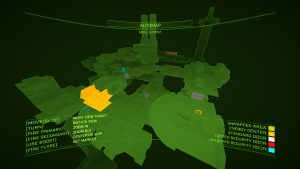
It’s no secret that first-person shooters have changed dramatically over the last two decades. Whereas they once tossed players into labyrinthine levels and expected them to find the exit all by themselves, today they usually take a much more linear, cinematic approach in which exploration is discouraged and the story is force-fed. Even the recent DOOM reboot, as fantastic as it was, had some awfully straight-forward levels (especially compared to the ’93 original) and several unskippable cutscenes.
Well ladies and gentlemen, I’m happy to report that Overload never got the memo.
Made by the creators of Descent, Overload is everything a fan could possibly hope for from a spiritual successor. It sports prettier graphics and a larger feature set while retaining everything that made the original game so special. The levels are still as large and complex as ever, weapons and enemies still come in great varieties, and yes, you still have to destroy reactors and run like hell before the whole place explodes.
If you’ve never before played Descent or any other six-degree-of-freedom (6DoF) shooter, you’re in for a trip. The 6DoF movement system means you can fly in literally every direction and even roll your ship. Although this can be quite disorienting and even nauseating (especially at first), it also gives you an unprecedented amount of control compared to traditional “grounded” first-person shooters. It makes combat more exciting, too, since threats can come from any angle and you aren’t just limited to strafing left and right in order to avoid incoming fire.
Overload’s campaign is broken up into 15 levels, three of which feature boss battles. Although that might not sound like a large number, the sheer size of these levels means you’ll be spending up to half an hour or more on each one. The levels are so complex, in fact, the developers not only included a full-fledged 3D automap but even implemented a “hologuide” that can be deployed at any time to lead you to the nearest powerup, security key, or even enemy. Best of all, the levels all play out without any interruptions. There aren’t any cutscenes whatsoever–only collectible audio logs–and even the pre-mission briefings can be skipped in an instant.
Perhaps the biggest change coming from Descent is the addition of an upgrade system which allows you to improve and modify both your ship and weapons over the course of the campaign. Some examples are the ability to make Missile Pods seek nearby enemies and a big boost to “smash” damage so that you can turn your ship into a powerful battering ram if the need ever arises. It’s worth noting, however, that upgrade points can only be acquired by finding and collecting them, therefore it’s strongly encouraged that you explore to your heart’s content if you wish to be at your very best going into each new level.
In addition to the campaign, there’s also a challenge mode (Overload’s take on horde mode) as well as local/online multiplayer. As someone who’s never been a huge fan of multiplayer in these types of games, challenge mode is my personal favorite. The goal is simple: survive for as long as possible against killer robots that constantly spawn in all around you. There are 12 arena-like stages to choose from and the more you play, the more XP you earn and the more persistent perks you unlock. It’s admittedly simple, but incredibly fun, highly replayable, and a great way to hone your combat skills.
Perhaps my favorite aspect of Overload aside from its oldschool nature (minimal cutscenes, maximum gameplay) is its vast array of weapons and enemies. There are 16 different weapons–yes, you can have them all at once–and my favorites include the Crusher, a punishing shotgun that can be upgraded to become fully automatic, and the Devastator, a large missile that explodes into a bomb cluster to deal insane damage. The enemy variety is even more impressive with over 20 different types of robots. You’ll encounter everything from Guardians, which pester you at long range with precision shots, to sawblade-armed Shredders that launch themselves at you arms-first with very bad intentions.
I also must bring attention to the game’s excellent soundtrack. The audio as a whole is great, from the weapons and explosions to the eerie, mechanical groans emitted by enemies themselves, but the soundtrack is what shines the brightest. Composed by Dan Wentz, Allister Brimble, and Jerry Berlongieri–all of whom worked on the Descent games–Overload’s soundtrack is a perfect revival of the same techno-like musical style that helped make those games so much fun to play and listen to.
Overload is one of those rare titles that, in the process of reviving a long-dead franchise, somehow manages to hit all the right notes. Even the graphics are surprisingly good, with excellent lighting effects and awesome, over-the-top explosions. The only complaint I can muster up is that I would’ve liked to have seen a greater variety of levels and locales, but I’m sure even that will be smoothed out in time thanks to the recently released level editor. Suffice it to say, if you’ve been longing for a new Descent or just a new oldschool first-person shooter in general, Overload is like a wish come true and you’d be doing yourself a great disservice to pass it up.